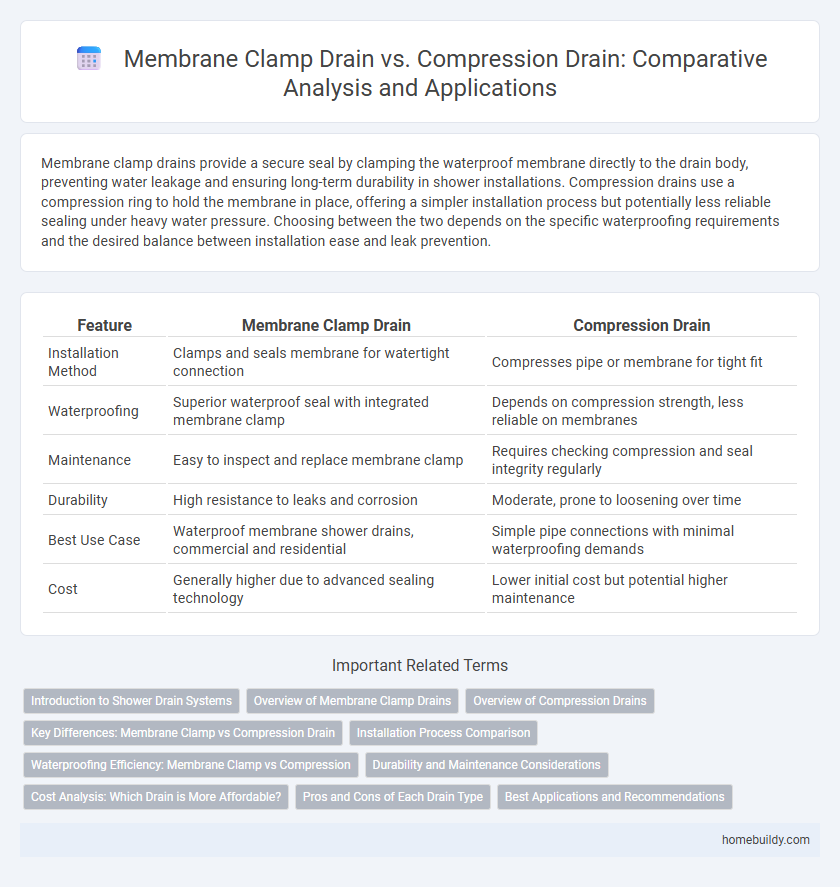Membrane clamp drains provide a secure seal by clamping the waterproof membrane directly to the drain body, preventing water leakage and ensuring long-term durability in shower installations. Compression drains use a compression ring to hold the membrane in place, offering a simpler installation process but potentially less reliable sealing under heavy water pressure. Choosing between the two depends on the specific waterproofing requirements and the desired balance between installation ease and leak prevention.
Table of Comparison
| Feature | Membrane Clamp Drain | Compression Drain |
|---|---|---|
| Installation Method | Clamps and seals membrane for watertight connection | Compresses pipe or membrane for tight fit |
| Waterproofing | Superior waterproof seal with integrated membrane clamp | Depends on compression strength, less reliable on membranes |
| Maintenance | Easy to inspect and replace membrane clamp | Requires checking compression and seal integrity regularly |
| Durability | High resistance to leaks and corrosion | Moderate, prone to loosening over time |
| Best Use Case | Waterproof membrane shower drains, commercial and residential | Simple pipe connections with minimal waterproofing demands |
| Cost | Generally higher due to advanced sealing technology | Lower initial cost but potential higher maintenance |
Introduction to Shower Drain Systems
Shower drain systems incorporate various components with membrane clamp drains and compression drains being two common options designed to secure the waterproof membrane and ensure a watertight seal. Membrane clamp drains use a clamping ring to hold the membrane firmly in place, preventing leaks and making them ideal for tile shower floors with thin-set or mortar beds. Compression drains utilize a compression fitting to secure the membrane, offering a simpler installation process and compatibility with flexible plumbing systems.
Overview of Membrane Clamp Drains
Membrane clamp drains provide a secure and watertight seal by clamping waterproof membranes directly into the drain body, ensuring reliable protection against leaks in shower installations. These drains are typically made from corrosion-resistant materials such as stainless steel or brass, enhancing durability and longevity. Their design facilitates easy integration with various waterproofing systems, making them a preferred choice for professional bathroom and wet room projects.
Overview of Compression Drains
Compression drains provide a secure and watertight connection for shower drainage systems by using a compression fitting that tightly seals around the drain pipe and membrane. Designed for compatibility with a variety of membrane types, these drains simplify installation while ensuring reliable waterproofing performance. Their robust construction prevents leaks and supports efficient water flow, making compression drains a preferred choice for many modern shower installations.
Key Differences: Membrane Clamp vs Compression Drain
Membrane clamp drains secure the waterproof membrane directly to the drain body, ensuring a watertight seal ideal for tile shower installations with thinset or mortar beds. Compression drains use a rubber gasket compressed between the drain and membrane, providing a flexible seal suitable for various membrane thicknesses but potentially less reliable over time. Membrane clamp drains offer superior long-term waterproofing performance, while compression drains are simpler to install and adjust.
Installation Process Comparison
Membrane clamp drains feature a simple installation process where the membrane is securely clamped between the body and the flange, ensuring a watertight seal without adhesives, which reduces the risk of leaks. Compression drains require tightening a compression ring to secure the membrane, demanding precise alignment and consistent pressure to avoid damage and ensure proper sealing. The membrane clamp drain often offers faster, more reliable installation with less technical skill compared to the more labor-intensive compression drain method.
Waterproofing Efficiency: Membrane Clamp vs Compression
Membrane clamp drains provide superior waterproofing efficiency by securely fastening the waterproof membrane between the clamp and the drain, creating a watertight seal that prevents leaks and moisture seepage. Compression drains rely on mechanical pressure to compress the membrane but may risk gaps or misalignment, potentially compromising the waterproof barrier over time. For long-term durability and optimal waterproof protection, membrane clamp drains are preferred in shower installations due to their reliable sealing performance.
Durability and Maintenance Considerations
Membrane clamp drains typically offer superior durability due to their robust sealing method, reducing the risk of leaks and water damage over time. Compression drains require periodic tightening and inspection to maintain a secure fit, increasing long-term maintenance efforts. Choosing a membrane clamp drain can lead to fewer repairs and enhanced longevity in shower drainage systems.
Cost Analysis: Which Drain is More Affordable?
Membrane clamp drains typically cost less upfront compared to compression drains due to simpler installation requirements and reduced material use. Compression drains often involve higher expenses because of more complex sealing components and labor-intensive fitting processes. For budget-conscious projects, membrane clamp drains offer a more affordable solution without compromising basic drainage functionality.
Pros and Cons of Each Drain Type
Membrane clamp drains offer superior waterproofing by securing the membrane tightly, reducing the risk of leaks in tiled shower installations, but they can be more complex to install and may require professional expertise. Compression drains provide easier and faster installation with adjustable compression rings to hold various membranes, yet they may be less effective at preventing water seepage over time compared to membrane clamp drains. Selecting between these types depends on balancing installation complexity, waterproofing durability, and maintenance preferences for optimal shower drain performance.
Best Applications and Recommendations
Membrane clamp drains are best suited for waterproofing systems requiring a secure seal over membranes, making them ideal for tiled showers and areas prone to water infiltration. Compression drains excel in epoxy or resin shower pan installations, providing a tight grip on the drain fitting for durable water resistance. For long-term reliability, select membrane clamp drains in membrane-lined surfaces and compression drains in solid, non-membrane substrates.
Membrane clamp drain vs compression drain Infographic

 homebuildy.com
homebuildy.com